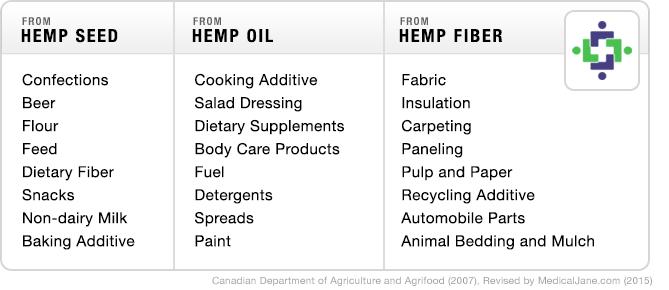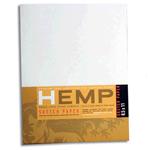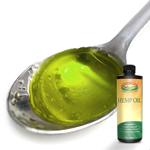What Is Hemp? Understanding The Differences Between Hemp and Cannabis
(article by Matt Price)
Industrial Hemp Uses
From hemp apparel and accessories to diets and hemp seed oil cosmetics, the plant is seemingly found everywhere you look. Hemp can be made into wax, resin, rope, cloth paper and fuel, among many other things.

Hemp for Paper
One of the reasons hemp is so valuable is because of its fiber length and strength. These long bast fibers have been used to make paper almost for 2 millennia. Thomas Jefferson drafted both the Declaration of Independence and the U.S. Constitution on hemp paper.
 Until the early 19th century, hemp and flax were the two chief paper-making materials. In historical times, paper was processed from hemp rag. Using hemp directly for paper was considered too expensive, due to its lack of demand at the time. Wood-based paper came into use when mechanical and chemical pulping was developed in the mid 1800s in Germany and England. Today, at least 95% of paper is made from wood pulp. This makes little sense when considering hemp can easily produce much more paper per acre than wood pulp alternatives.
Until the early 19th century, hemp and flax were the two chief paper-making materials. In historical times, paper was processed from hemp rag. Using hemp directly for paper was considered too expensive, due to its lack of demand at the time. Wood-based paper came into use when mechanical and chemical pulping was developed in the mid 1800s in Germany and England. Today, at least 95% of paper is made from wood pulp. This makes little sense when considering hemp can easily produce much more paper per acre than wood pulp alternatives.
The hemp paper process also utilizes less energy and fewer chemicals than tree paper processing and doesn’t create the harmful dioxins, chloroform, or any of the other 2,000 chlorinated organic compounds that have been identified as byproducts of the wood paper process.
According to Hemp: A New Crop with New Uses for North America, “the primary bast fibers in the bark are 5–40 mm long, and are amalgamated in fiber bundles which can be 1–5 m long (secondary bast fibers are about 2 mm long). The woody core fibers are short—about 0.55 mm—and like hardwood fibers are cemented together with considerable lignin. The core fibers are generally considered too short for high grade paper applications (a length of 3 mm is considered ideal), and too much lignin is present.”
Hemp for Food
Studies have shown consumption of raw hemp seeds can help lower blood pressure and cholesterol, accelerate weight loss, improve one’s immune system, control blood sugar levels, and even reduce inflammation. This makes hemp seeds extremely nutritious. They contain a bundle of essential amino acids and fatty-acids. This may explain why the “hemp for food” industry is growing rapidly and has increased over 300 percent, to an estimated 25,000 products, in the past few years.
 In its raw form, hemp has the second highest amount of protein of any food (soy being the highest). However, because the hemp seed’s protein more closely resembles the protein found in human blood, it is much easier to digest than soy protein. Hemp seeds can be eaten whole, pressed into oil, or ground into flour for baking.
In its raw form, hemp has the second highest amount of protein of any food (soy being the highest). However, because the hemp seed’s protein more closely resembles the protein found in human blood, it is much easier to digest than soy protein. Hemp seeds can be eaten whole, pressed into oil, or ground into flour for baking.
In America, products derived from hemp seed, such as hemp seed spreads, hemp seed energy bars, hemp seed meal, and hemp oil – are widely available in natural food stores such as Whole Foods or Trader Joe’s supermarkets.
Hemp for Health & Body
Hemp seed oil is perfectly suited for hair and skin care. Its nutritional value, combined with its moisturizing and replenishing EFA’s, make it one of the best vegetable body care foundations. Hemp seed oil’s EFA complement includes polyunsaturated fatty acids, omega-3, omega-6, omega-9, linoleic acid, and gamma linoleic acids (GLA’s). Although they are very effective in skin care maintenance, GLA’s are rarely found in natural oils. Hemp is an excellent source of GLA’s.
Additionally, oil derived from hemp seed has shown promise in treating eczema (chronic dry skin) in patients, although whole-plant cannabis oil has been proven to be more effective in treating more severe skin disorders, like skin cancer.
Hemp for Fuel
Hemp seeds have provided a combustible fuel oil throughout human history. Basically, hemp can provide two types of fuel:
1. Hemp biodiesel – made from the oil of the (pressed) hemp seed.
2. Hemp ethanol/methanol – made from the fermented stalk.
2. Hemp ethanol/methanol – made from the fermented stalk.
The concept of using oil derived from vegetables as an engine fuel is nothing new. In 1895, Dr. Rudolf Diesel developed the first diesel engine to run on vegetable oil — peanut oil to be exact. When you press the hemp seeds and extract the oil, you are actually creating hemp biodiesel. Additionally, through processes such as gasification, hemp can be used to make both ethanol and methanol.
The Controversy of Classifying Hemp vs. Cannabis
The international definition of hemp (as opposed to cannabis) was developed by a Canadian researcher in 1971 who goes by the name of Ernest Small. Small’s arbitrary 0.3 percent THC limit has become standard around the world as the official limit for legal hemp, after he published a little-known, but very influential book titled The Species Problem in Cannabis.
“There is not any natural point at which the cannabinoid content can be used to distinguish strains of hemp and marijuana. – Ernest Small”
In this same book, Small discusses how “there is not any natural point at which the cannabinoid content can be used to distinguish strains of hemp and marijuana.” Despite this, Small continued to “draw an arbitrary line on the continuum of cannabis types, and decided that 0.3 percent THC in a sifted batch of cannabis flowers was the difference between hemp and marijuana.” As you can imagine, this has led to some controversy and confusion as to what truly constitutes the difference between hemp and cannabis.
Additionally, your location will determine your understanding of what constitutes hemp vs cannabis. For instance, Health Canada defines hemp as products of Cannabis Sativa which contain less than 0.3 percent THC, whereas U.S. law defines hemp as all parts of any Cannabis Sativa plant containing no psychoactive properties, except for defined exceptions.
A recent court case between Hemp Industries Association v. DEA concluded “the DEA can regulate foodstuffs containing natural THC if it is contained within marijuana, and can regulate synthetic THC of any kind. But they cannot regulate naturally-occurring THC not contained within or derived from marijuana—i.e., non-psychoactive hemp products— because non-psychoactive hemp is not included in Schedule I.”

No comments:
Post a Comment